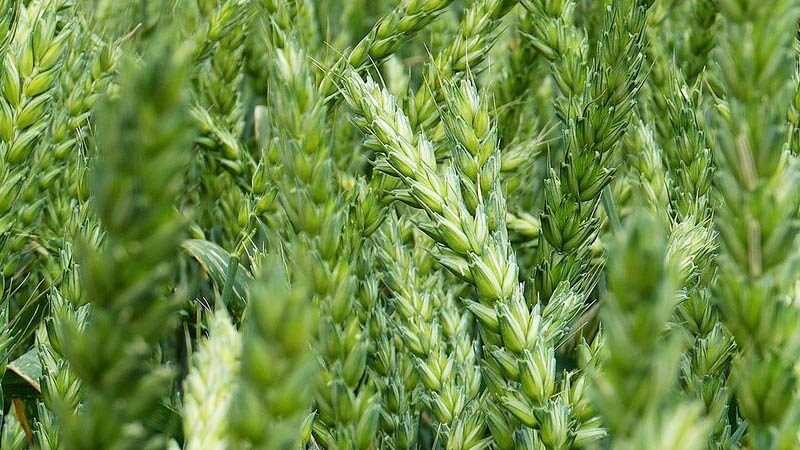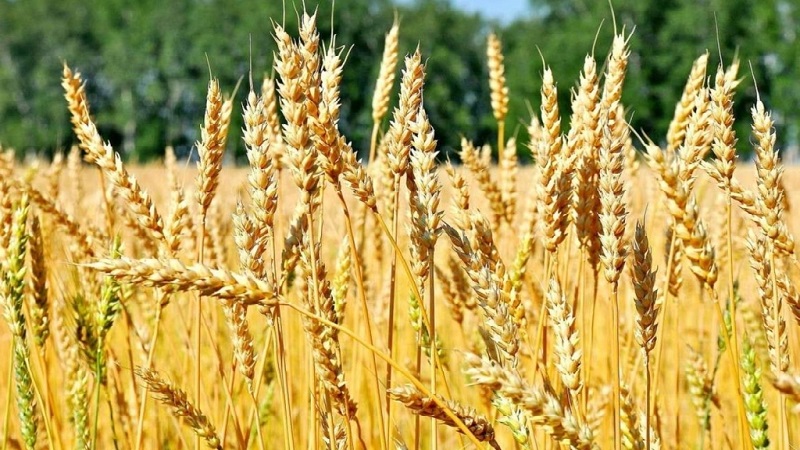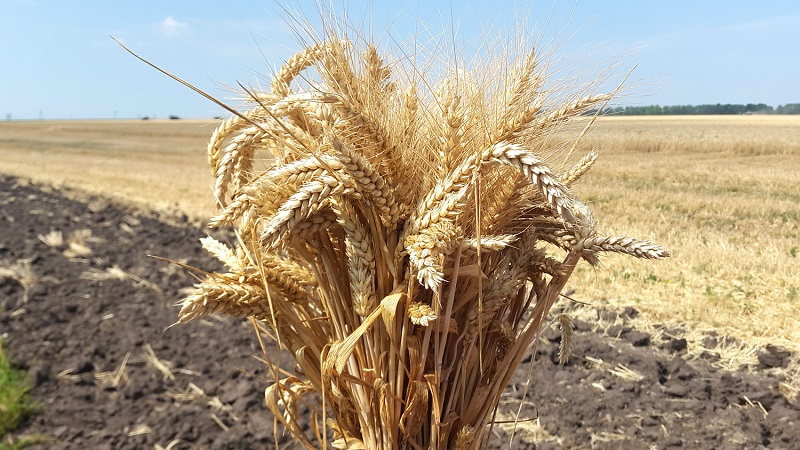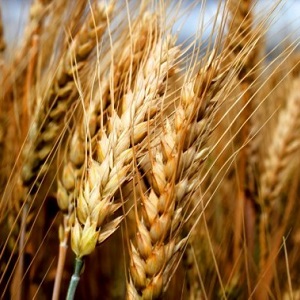Description and characteristics of the winter wheat variety "Bagrat"
Wheat is a popular food crop in Russia with healthy properties and is used in various sectors of the economy. One of the most popular winter varieties is Bagrat. How did he deserve national recognition?
The content of the article
Description
Bagrat is a medium early wheat variety with good grain quality and intense spring growth. The cereal is medium-sized - it reaches a height of about 1 m.

Bagrat has increased resistance to:
- cold and frosty;
- drought;
- lodging;
- shedding;
- diseases.
An ear of pyramidal shape, medium density, reaches 11 cm in length... In the upper part there are osteiform processes of 2–4 mm. The scales are ovoid, length - 9.5 mm, width - no more than 4.5 mm. The tooth is straight or slightly curved.
Origin story
Bagrat - an achievement of domestic breeders, employees of the Krasnodar Research Institute of Agriculture named after P. P. Lukyanenko. Since 2011, the cereal has been under state variety testing, in 2015 it was officially registered.
Reference. The variety was obtained by backcrossing Moskovskaya 39 wheat with the Lutescens 201-93k3 line. It owes its name to its author - Bagrat Sandukhadze.
Features and taste
The grain is medium in size, elongated. It is bare at the base, does not have a deep groove.
Suitable for baking purposes... It has a bland taste with a slightly sweetish note due to the glucose it contains.
Benefits
Dignity of Bagrat wheat - high grain productivity, which is observed even in conditions of medium and low agricultural background.
The table shows comparison of popular crop varieties:
| Name | Germination rate,% | Yield indicator, c / ha | Maximum weight of 1000 grains, g |
| Bagrat | 96 | 88 | 46 |
| Antonina | 95 | 53,4 | 44,3 |
| Caravan | 96 | 78,3 | 44,6 |
Specifications
Bagrat is a mid-early variety: the duration of the growing season is 219-278 days. The grain ripens 1–3 days earlier than that of the Pamyat and Ivina varieties.
Seeding rate - 5,000,000 viable seeds per 1 ha... As the crop grows, it occupies the entire field, suppressing weeds and shading the soil. Thanks to the shadow created by the ears, the earth does not dry out.

Drought tolerance
To assess the resistance of wheat varieties to drought, agronomists use a five-point scale. The lowest rate is given to plants that die in arid climates. The highest score goes to varieties that grow normally in such conditions.
Bagrat highly drought-resistant on par with the Memory standard.
By the way! The variety does not fall or crumble. The last indicator is determined when over-growing at the root.
Disease resistance
Bagrat has strong immunity, resistant to such diseases:
- dusty smut;
- brown and stem rust;
- powdery mildew.
Average susceptibility to:
- septoria;
- fusarium spike;
- hard smut;
- yellow rust;
- leaf spot;
- viruses.
Cold tolerance
Bagrat's frost resistance is above average for wheat, slightly inferior to the Don 107 standard. At a temperature of -15 ° C, 98% of plants are preserved. The variety is suitable for cultivation in the climatic conditions of the North Caucasus.
About other cereals:
What are the varieties of barley, their characteristics and description
Growing features
Winter wheat has 2 active growing seasons: autumn and spring-summer. The first one lasts 45-50 days. At this time, the vegetative organs of plants develop. The second stage takes 75-100 days and is characterized by the formation of generative organs.
Important! Seeds germinate at + 1 ° C, but for friendly seedlings, the ambient temperature should be + 12 ... + 15 ° C. Good growth and development of plants occurs at + 16 ... + 22 ° C, grain filling - at + 22 ... + 25 ° C.
Seeds are planted 3–5 cm deep, the field is rolled up. The later the sowing time, the closer the planting material is to the surface.
Bagrat wheat is sown in the usual row method. Row spacing - 15 cm.

Predecessors
Wheat is a very demanding crop for its predecessors. What has previously grown in the field determines how much the soil will be enriched with nutrients and moistened by the time of sowing. This also affects the quality of the crop.
Bagrat is planted after tilled and spiked predecessors:
- perennial and one-year herbs;
- legumes;
- corn for green forage or silage;
- siderate, rocker and clean steam;
- buckwheat;
- rapeseed;
- early and mid-season potatoes.
Sowing after oats will keep the wheat from root rot and saturates the earth with nutrients necessary for the normal growth and development of plants.
Repeated sowing of winter cereal varieties in the same field is permissible after 2 years... Otherwise, the risk of disease and pests affecting wheat increases.
Important! Do not plant a crop after barley, otherwise the plants will suffer from root rot.
Landing dates
The optimal sowing dates for winter wheat varieties such as Bagrat are September 10–20... If unpaired predecessors were grown in the field before the cereal or the soil is not fertile, planting is carried out in early September.
On fertile soil and after steam predecessors, cereals are planted later so that by winter the plants do not overgrow and are less susceptible to damage by cereal flies.
By wintering, the culture should grow for 55-60 days. and form 2-4 full sprouts.
Read also:
Soil requirements
Winter varieties are characterized by increased demand for soil... They need a highly fertile, structural soil saturated with a sufficient amount of trace elements (nitrogen, phosphorus, potassium).
The optimum pH is 6.0–7.5.
Reference. Chernozems are most suitable for sowing wheat.
The soil is pre-treated and monitored to ensure that it is:
- optimal density and structure;
- well aerated;
- moisturized;
- rid of weeds;
- fertilized;
- aligned for sowing.

Care
Planting care includes fertilization, pest control and weed control.
Top dressing
The rate of necessary fertilizers is calculated taking into account:
- predecessors;
- the mechanical composition of the soil;
- the degree of soil enrichment with micronutrients.
The effective rate of organic fertilizing for winter planting for a busy fallow is 20-30 t / ha.
Phosphate and potash fertilizers provide:
- correct development of seedlings;
- increased frost resistance;
- lodging resistance;
- reducing the risk of disease;
- improving the quality of grains.
All the necessary potash fertilizers are applied for the main cultivation of the land... This also applies to phosphorus dressings: they are added at sowing 10–20 kg each. Positively affect the yield and nitrogen compositions applied in 3-4 doses.
The first early spring feeding carried out by the root method. The second is during the period when plants enter the tube for the formation of a productive stalk. The third - when moving from heading to pouring grain.
Pest control
Winter wheat crops are threatened with defeat:
 a harmful bug;
a harmful bug;- bread beetle;
- bread beetle;
- cereal fly;
- cereal aphid;
- wheat thrips;
- striped bread flea;
- red-breasted drunk.
Various agrotechnical measures are carried out to combat pests, including the timely processing of the soil.
Important! Insecticides are used only in case of significant insect infestation, which threatens to seriously damage the crop.
From cereal aphids, harmful turtles, beetles and thrips, crops are treated "Zolon", "Decisom", "Karate".
Weed control
Among the weeds that harm winter cereals, there are:
- sow thistle;
- chamomile;
- cornflower blue;
- cleavers;
- stellate is average.
Herbicides are used to control weeds: "Arkan", "Bazagran", "Starane", "Dialen Super", "Logran", "Cowboy", "Dikopur F".
Reference. The crop is harvested by combining when the grain is fully ripe and the moisture content is 14–17%.
Yield characteristic
The variety has good yield indicators... Krasnodar agronomists get 88.7 centners of grain from 1 hectare when sowing wheat after corn for grain. After the spike predecessor, Bagrat gives about 82.5 c / ha. The maximum indicator - 84.3 c / ha - was obtained in the Stavropol Territory.
The Bagrat wheat yield exceeds the Memory standard by an average of 9.6 c / ha.
Conclusion
Bagart is a popular winter wheat variety in Russia. Grain produces high-quality grain, has a strong immunity to disease, is resistant to drought, cold weather, lodging and shedding. Compliance with the rules of agricultural technology of grain crops ensures the receipt of high-quality grain.